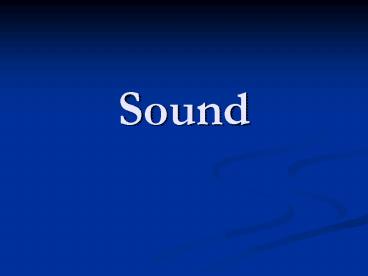Sound - PowerPoint PPT Presentation
1 / 19
Title:
Sound
Description:
Properties of Sound. Interference. The Doppler Effect. Resonance. Harmonics. Longitudinal Waves ... travel at the speed of sound (apx 750 mph ) are traveling at ... – PowerPoint PPT presentation
Number of Views:135
Avg rating:3.0/5.0
Title: Sound
1
Sound
2
Overview
- Properties of Sound
- Interference
- The Doppler Effect
- Resonance
- Harmonics
3
Longitudinal Waves
- Sound requires two things
- Disturbance
- Medium
- Comprised of a series of compressions (high
density) and rarefactions (low density).
4
Velocity
- v f l
- The velocity of sound depends on
- The temperature
- Cooler temperature means a slower speed.
- The density of the material. (medium)
- Sound travels at 343 m/s through 20C air.
5
Speed in Different Mediums
- Gases
- Hydrogen 1290 m/s
- Helium 972 m/s
- Oxygen 317 m/s
- Liquids
- Sea Water 1530 m/s
- Water 1490 m/s
- Solids
- Iron 5130 m/s
- Aluminum 5100 m/s
- Lead 1320 m/s
6
Sonic Booms
- Objects that travel at the speed of sound (apx
750 mph ) are traveling at mach 1. - Travel at twice the speed and youre at mach 2.
- As an object approaches the speed of sound, the
waves pile up in front of the object. This causes
the amplitude to be very large when the object
punches through the pile of waves. - The waves follow behind the airplane.
7
Pitch
- Pitch refers to the frequency of sound
- Human range 20 Hz to 20,000 Hz
- The ear is most sensitive to frequencies between
1000 Hz and 5000 Hz. - Infrasonic Waves frequencies below the audible
region - Earth quakes, Large Machines
- Ultrasonic Waves frequencies above the audible
region - Medical, Echolocation
8
Did You Know?
- Elephants use infrasonic sound waves to
communicate with one another. Their large ears
enable then to detect these low frequencies.
9
Loudness
- Loudness refers to the amplitude of the wave
- Ears responds from 0.00002 N/m2 to 20 N/m2
- Units decibels (dB)
- A 10 dB increase in sound is perceived to be
twice as loud. - Perceived loudness also depends on the frequency.
- Timbre refers to the quality of sound
10
Intensity
- Intensity the rate at which energy is
transferred through a certain area - I P/area
11
Decibel Scale
12
Beats
- If two frequencies are slightly different, a
third frequency can be detected. This is called a
beat. - The beat frequency is calculated by taking the
difference between the two frequencies. - The ear can detect beat frequencies up to 7 Hz.
- Used to tune instruments.
13
Echoes and Reverberation
- Echo reflection of sound.
- Reverberation multiple reflection in a small
area - SONAR SOund NAvigation and Ranging
- Uses an echo to determine distance
14
Doppler Effect
- The Doppler effect is the apparent change in
frequency due to a moving source or receiver. - Example train passing, radar detectors
- The pitch increases as the distance between the
source and receiver decreases. - Pitch decreases as the distance increases.
- Note The velocity of the wave does not change.
15
Doppler Effect
If the source and receiver are moving towards
each other
If the source and receiver are moving away from
each other
16
Resonance
- Adding energy at just the right frequency to get
the amplitude to increase. - Example breaking a crystal glass
17
Harmonics
- Consider a violin string.
- Each end represents a node.
- Therefore the length, L of the string is ½ l.
- fv/ l v/2L (fundamental frequency)
18
Closed Pipe Resonator
Sound
L ¾ l
- Closed pipe resonator. (one end is closed)
- A standing wave is formed when the reflected and
incident wave are in-phase.
L ½ l
Sound
No Sound
L ¼ l
19
Open Pipe Resonator
No Sound
- Open at both ends
L ¾ l
Sound
L ½ l
No Sound
L ¼ l































